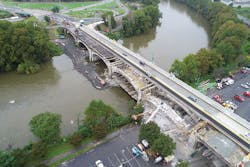NO. 5 BRIDGE: Penn Street Historic Bridge Rehabilitation
Constructed in 1913, the 14-span historic Penn Street Bridge is a vital link between S.R. 422 and downtown Reading in Berks County for 22,000 daily commuters.
This “Gateway to Reading” serves as a key connection between the Reading and West Reading communities, making the bridge crucial to the region’s economic vitality. When PennDOT undertook a $42.5 million rehabilitation project, maintaining both vehicular and pedestrian access during the entire construction process was essential.
To overcome this complex challenge, project designers developed a comprehensive traffic control plan to preserve regional mobility throughout the project. With a full interchange on one side and an urban signalized intersection on the other, the detailed plan accommodated a primary/secondary ramp detour, a temporarily relocated ramp, and maintained three traffic lanes during six construction stages and pedestrian traffic above and below the bridge.
The team made certain that the rehabilitation design would accommodate the complicated staging sequence. A thorough structural analysis ensured that the three arch ribs that make up open-spandrel spans could safely support traffic when lanes were shifted so that portions of the deck, floor beams, and selected spandrel columns could be replaced. Temporary sheeting on the closed-spandrel spans supported the fill that carried traffic when adjacent excavation was performed, cellular fill was placed, and the moment slabs installed.
The team researched an innovative coating system to protect the bridge’s existing and new concrete elements, while providing a uniform appearance sensitive to the structure’s historical significance. After removing shotcrete applied in the 1950s and patching the original concrete to restore its integrity, the team applied a two-part, breathable, polymer-modified, cementitious base coat to the entire structure. The system has an estimated effective service life of 20 years.
Early in design it was understood that traffic would “drive” much of the approach to construction. A traffic study concluded that three lanes should be maintained, leaving narrow construction zones on the bridge. To address the access issues this presented, the project access focused on maximizing access from below the bridge so that traffic could flow smoothly. To prevent traffic in the downtown business district, two lanes out of the city were maintained throughout the project, alleviating congestion on city streets. A 31,000-sq-ft causeway in the Schuylkill River enabled the contractor to overcome the site constraints by providing access to the open-spandrel spans and allowing heavy equipment to reach the river spans.
It was a goal of the project to better connect West Reading and Reading divided by the river. To facilitate safe pedestrian passage, the rehabilitated bridge features a new crashworthy barrier at the curb protecting a 7-ft-wide sidewalk. Five-ft-wide shoulders incorporating bicycle-safe grates create a buffer between the sidewalk and traffic and allow the creation of a bike lane in the future. Traffic lanes narrowed from 13 ft to 11 ft help deter vehicles from speeding across the bridge, further enhancing safety.
To faithfully restore the bridge’s distinctive architectural detailing, designers turned to the original bridge drawings developed in the early 1910s to recreate details on the arch rings, piers, and reticulated balustrades. The reconstruction of reticulated balustrades with outlooks restored the bridge’s historical appearance and aesthetic appeal. To incorporate past details of the bridge and to create an entrance to the city, the obelisks previously on the bridge were recreated on the east end and are illuminated with color-changing lights for the city to alter for holidays and civic events. To showcase the restored bridge, aesthetic lighting was added beneath the bridge.
“One of the keys to this project’s success was community involvement,” Kristina Lammi Thompson, Cultural Resources Specialist at PennDOT, told Roads & Bridges. “The bridge is an iconic component of the city’s built environment and is valued at a local and regional level. Its eligibility for the National Register of Historic Places required consultation with stakeholders on the rehabilitation plans. Participants in this process included county and city officials, local property and business owners, and people invested in the communities’ economic redevelopment. Their varied perspectives helped the team identify the components of the project most important to the community. Their input heavily influenced the rehabilitation’s success.”
Rehabilitation of the Penn Street Bridge was completed four weeks ahead of schedule and was within 2% of the contractor’s original bid price. Structurally sound and designed to extend service life, the rehabilitated landmark offers inspiration for future development to further enhance the Reading community.

